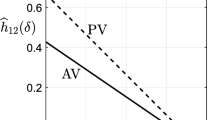Abstract
Approval Voting is known to possess many good properties when voters have dichotomous preferences. But, when attention was restricted to the limiting case for large electorates with three candidates in an early study, Approval Voting was found to have the same Condorcet Efficiency as both Plurality Rule and Negative Plurality rule when no voter indifference is allowed in voters’ preferences with the assumption of the impartial culture condition (IC). However, a later study by Diss et al. (Handbook on approval voting, 2010) shows that the introduction of any degree of indifference in an extended impartial culture condition leads to a dominance of Approval Voting over both Plurality Rule and Negative Plurality Rule on the basis of Condorcet Efficiency. Scenarios were also found for which Approval Voting had greater Condorcet Efficiency than Borda Rule. The assumptions of that study are analyzed here, and an arguably more reasonable set of assumptions leads to the conclusion that Borda Rule will dominate Approval Voting on the basis of Condorcet Efficiency for all degrees of voter indifference, except for the case of completely dichotomous preferences. The same outcome is found to result in the current study for an extended version of the Impartial Anonymous Culture Condition.

Similar content being viewed by others
Notes
LattE homepage http://www.ucdavis.edu/”latte
Of course, the methodological choices in this Section are also made for the sake of simplicity: if the number of voter preference types is too high, the desired representations become either impossible to derive or too complex to be useful.
References
Barvinok A (1993) A polynomial time algorithm for counting integral points in polyhedral when the dimension is fixed. In: 34th annual symposium on foundations of computer science. November 1993. IEEE, pp 566–572
Berg S (1985) Paradox of voting under an urn model: the effect of homogeneity. Public Choice 47:377–387
Brams SJ, Sanver R (2009) Voting systems that combine approval and preferences. In: Brams SJ, Gehrlein WV, Roberts FS (eds) The mathematics of preference, choice and order. Springer, Berlin, pp 215–237
Condorcet M de (1785) An essay on the application of probability theory to plurality decision making: An election between three candidates. In: Sommerlad F, McLean I (eds) The political theory of Condorcet. University of Oxford Working Paper, Oxford, pp 69–80 (1989)
Diss M, Merlin V, Valognes F (2010) On the condorcet efficiency of approval voting and extended scoring rules for three alternatives. In: Laslier J-F, Sanver RM (eds) Handbook on approval voting. Springer, Berlin, pp 255–283
Gehrlein WV, Fishburn PC (1978) Probabilities of election outcomes for large electorates. J Econ Theory 19:38–49
Gehrlein WV (1979) A representation for quadrivariate normal positive orthant probabilities. Commun Stat 8:349–358
Gehrlein WV (1982) Condorcet efficiency and constant scoring rules. Math Soc Sci 2:123–130
Gehrlein WV, Lepelley D (1998) The Condorcet efficiency of approval voting and the probability of electing the Condorcet loser. J Math Econ 29:271–283
Gehrlein WV, Valognes F (2001) Condorcet efficiency: a preference for indifference. Soc Choice Welf 18:193–205
Guilbaud GT (1952) Les théories de l’intérêt général et le problème logique de l’agrégation. Economie Appliquée 5:501–584
Johnson NL, Kotz S (1972) Distributions in statistics: continuous multivariate distributions. Wiley, New York
Lepelley D, Louich A, Smaoui H (2008) On Ehrhart polynomials and probability calculations in voting theory. Soc Choice Welf 30:363–383
De Loera JA, Hemmecke R, Tauzer J, Yoshida R (2004) Effective lattice points counting in rational convex polytopes. J Symb Comput 38:1273–1302
Slepian D (1962) The one sided barrier problem for Gaussian noise. Bell Syst Tech J 41:463–501
Wilson MC, Pritchard G (2007) Probability calculations under the IAC hypothesis. Math Soc Sci 54:244–256
Young HP (1974) An axiomatization of Borda rule. J Econ Theory 9:43–52
Author information
Authors and Affiliations
Corresponding author
Additional information
The authors are grateful to Mostapha Diss for his comments on an early draft of this paper. They also thank an anonymous referee for helpful remarks and suggestions.
Rights and permissions
About this article
Cite this article
Gehrlein, W.V., Lepelley, D. The Condorcet Efficiency Advantage that Voter Indifference Gives to Approval Voting Over Some Other Voting Rules. Group Decis Negot 24, 243–269 (2015). https://doi.org/10.1007/s10726-014-9388-4
Published:
Issue Date:
DOI: https://doi.org/10.1007/s10726-014-9388-4



